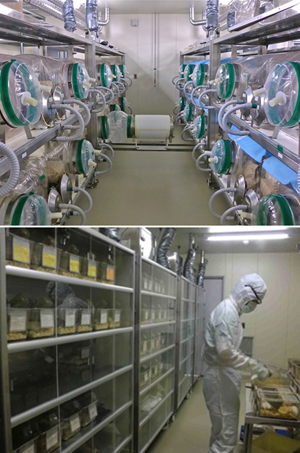Breeding Technology Laboratory
We supply precision animal models possessing high reproducibility, disseminate their rearing and management techniques, and provide contract research using our animal resources and rearing techniques.
Mouse resources, represented by severely immunodeficient NOG mice, are produced worldwide and are responsible for strain preservation and genetic refresh of their foundation colonies.
We also provide consultations on the improvement of the rearing and experimental environments for NOG mice and related mouse lines (Next-Generation NOGs).
Gnotobiotic Animal Laboratory
On the basis of Germ-free/Gnotobiotic animal rearing and management techniques cultivated since the 1960s, we can create mice with modified microbiomes.
We are working to develop experimental techniques and breeding equipment for microbiome animal experiments, and we are providing these techniques as contract research.
We also provide consultation, education, and training on Germ-free/Gnotobiotic animal-related techniques.
The Japanese Association of Germfree Life and Gnotobiology (JAGG) is a historical society established in 1968.
From 2022, the secretariat of the society will be relocated to Central Institute for Experimental Medicine and Life Science.
Please refer to the URL below.
The Japanese Association of Germfree Life and Gnotobiology (JAGG)
Breeding equipment (film isolators, isolation breeding racks) and laboratory research equipment developed at CIEM are commercialized by JIC Co., Ltd. Please see the following URL.
JIC Co., Ltd.
【Activities】
- Development of rearing and management techniques
- Collection of physiological data and performance evaluation of various mouse strains
- Maintenance, storage, and supply of inbred mice
- Education and training on rearing and management of severely immunodeficient mice
- Custom microbiological cleaning for germ-free and gnotobiotic mice
- Development of breeding technology for microbiome animal experiment
- Distribution of germ-free and gnotobiotic mouse strain
- Contract/Collaborative research using germ-free and gnotobiotic animals
※References
-
Creation of an experimental rearing environment for microbiome animal research using an individually ventilated cage system and bioBUBBLE enclosure.
Ka Y, Ogura T, Tomiyama K, Ueno M, Nozu R, Tsuruzono N, Nozawa Y, Hamano M, Takakura A, Takahashi R.
Exp Anim. 2021 May 13;70(2):177-184.
-
Characterization of hiPSC-Derived Muscle Progenitors Reveals Distinctive Markers for Myogenic Cell Purification Toward Cell Therapy.
Nalbandian M, Zhao M, Sasaki-Honda M, Jonouchi T, Lucena-Cacace A, Mizusawa T, Yasuda M, Yoshida Y, Hotta A, Sakurai H.
Stem Cell Reports. 2021 Apr 13;16(4):883-898.
-
Improved engraftment of human peripheral blood mononuclear cells in NOG MHC double knockout mice generated using CRISPR/Cas9
Ka Y, Katano I, Nishinaka E, Welcker J, Mochizuki M, Kawai K, Goto M, Tomiyama K, Ogura T, Yamamoto T, Ito M, Ito R, Takahashi R.
Immunol Lett. 2021 Jan;229:55-61.
-
Study on AAV-mediated gene therapy for diabetes in humanized liver mouse to predict efficacy in humans.
Hashimoto H, Mizushima T, Ogura T, Kagawa T, Tomiyama K, Takahashi R, Yagoto M, Kawai K, Chijiwa T, Nakamura M, Suemizu H.
Biochem Biophys Res Commun. 2016 Sep 23;478(3):1254-60.
-
Predominant development of mature and functional human NK cells in a novel human IL-2-producing transgenic NOG mouse.
Katano I, Takahashi T, Ito R, Kamisako T, Mizusawa T, Ka Y, Ogura T, Suemizu H, Kawakami Y, Ito M.
J Immunol. 2015 Apr 1;194(7):3513-25.
-
NOD-Rag2null IL-2Rγnull mice: an alternative to NOG mice for generation of humanized mice.
Katano I, Ito R, Kamisako T, Eto T, Ogura T, Kawai K, Suemizu H, Takahashi T, Kawakami Y, Ito M.
Exp Anim. 2014;63(3):321-30.
-
A versatile technique for the in vivo imaging of human tumor xenografts using near-infrared fluorochrome-conjugated macromolecule probes.
Suemizu H, Kawai K, Higuchi Y, Hashimoto H, Ogura T, Itoh T, Sasaki E, Nakamura M.
PLoS One. 2013 Dec 17;8(12):e82708.
-
Establishment of a human allergy model using human IL-3/GM-CSF-transgenic NOG mice.
Ito R, Takahashi T, Katano I, Kawai K, Kamisako T, Ogura T, Ida-Tanaka M, Suemizu H, Nunomura S, Ra C, Mori A, Aiso S, Ito M.
J Immunol. 2013 Sep 15;191(6):2890-9.
